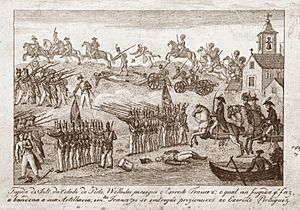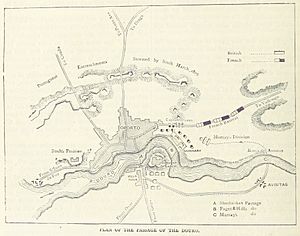Second Battle of Porto facts for kids
Quick facts for kids Second Battle of Porto |
|||||||
|---|---|---|---|---|---|---|---|
| Part of the Peninsular War | |||||||
 Portuguese and British regiments pursuing the retreating French army at the Second Battle of Porto |
|||||||
|
|||||||
| Belligerents | |||||||
| Commanders and leaders | |||||||
| Strength | |||||||
| 13,000 | 18,400-27,000 | ||||||
| Casualties and losses | |||||||
| 2,100-2,400 600 killed or wounded 1,500 captured |
150 | ||||||
The Second Battle of Porto, also known as the Battle of the Douro, was an important fight during the Peninsular War. It happened on May 12, 1809. In this battle, General Arthur Wellesley (who later became the Duke of Wellington) led his British and Portuguese army to defeat the French troops. The French army was led by Marshal Soult. Wellesley's victory allowed his forces to take back the city of Porto in Portugal.
Wellesley took charge of the British troops in Portugal on April 22, 1809. He quickly moved towards Porto. He surprised the French by crossing the Douro River in an unexpected spot. This allowed his army to attack Porto where its defenses were weak. Marshal Soult tried to organize a defense, but it was too late. The French army quickly left the city in a messy retreat. This battle marked the end of the Second French invasion of Portugal. Soult's escape route to the east was blocked. He had to destroy his cannons and burn his supplies. Wellesley chased the French, but Soult's army managed to escape by fleeing through the mountains.
Contents
Background to the Battle
The Peninsular War was a big conflict in Europe. The Second French invasion of Portugal had already started. Before this battle, there was another fight called the First Battle of Porto.
French Control of Porto
In the First Battle of Porto on March 28, 1809, the French army under Marshal Soult defeated the Portuguese forces. This battle happened just outside the city of Porto. After winning, Soult's army attacked and took over the city. Many soldiers and civilians died during this attack.
While Soult was in Porto, some of his troops were operating to the east. This group was led by General Loison. A Portuguese force, led by General Francisco Silveira, captured the French soldiers in Chaves. This blocked Soult's way to communicate with Spain.
From April 18 to May 3, the Portuguese kept General Loison's forces stuck on one side of the Tâmega River. On May 3, French engineers managed to clear a bridge that had been set with explosives. This allowed French soldiers to cross. By May, Marshal Soult worried that the British army outnumbered his forces. He stayed up late on May 11, making plans for his army to retreat. Some of his troops, along with their supplies and cannons, had already been sent away.
Soult still had about 10,000 foot soldiers and 1,200 cavalry (soldiers on horseback). His army included different divisions of infantry and cavalry regiments.
British and Portuguese Advance
After coming from Lisbon, the combined British and Portuguese army had a small fight with the French. This happened at the Battle of Grijó on May 11. When Wellesley's army reached the Douro River, they couldn't cross. Soult's army had either destroyed all the boats or moved them to the northern side of the river.
Wellesley's army was quite large, with about 18,400 soldiers. It included several divisions of infantry and cavalry. There were also four artillery batteries with cannons of different sizes. Marshal William Carr Beresford led another group of British and Portuguese soldiers. They were moving to meet up with General Silveira's forces further east.
The Battle Begins
On the morning of May 12, Colonel John Waters was given a task by Wellesley. He needed to find a way for the army to cross the Douro River, east of Porto. A local barber helped him find a hidden spot on the riverbank. There was a small boat there. Colonel Waters and his men crossed the wide river. They brought back four wine barges from the other side. These barges were unguarded. A local priest and a few villagers also helped them.
When Wellesley heard about this chance, he immediately told his men to cross. A small group of 25 soldiers from the 3rd Foot regiment quickly crossed the river. They took over a walled seminary building that overlooked the crossing point. More soldiers quickly followed them. By the time the French realized what was happening, Wellesley's forces were already making their position strong. More soldiers from Hill's brigade were crossing in other barges.
Marshal Soult was asleep and did not know about these events. General Maximilien Foy was the first French officer to see the British crossing. He quickly gathered three battalions of soldiers and attacked the seminary around 11:30 am. General Foy was wounded, and his soldiers were forced back with many losses. Later that day, the French attacked again with more soldiers. But by then, three more British battalions had taken over the seminary and nearby buildings. The French were defeated once more.
Soult then pulled back the troops who were guarding the boats in Porto. He sent them to help General Foy.
As soon as the French left the riverside, the people of Porto quickly got into "anything that would float." They helped ferry more British troops across the river. Four British battalions crossed right away and attacked the French from behind. The French army had been planning a slow exit from the city. Instead, they fled very quickly to the northeast.
To stop the French from escaping, General John Murray's brigade of 2,900 men, along with cavalry, had been sent to cross the Douro. They crossed at a ferry five miles east of Porto. However, Murray did not block the French escape route, though there was a small fight. The cavalry, however, chased after the retreating French. They charged and managed to cut off about 300 French soldiers, capturing many of them. Out of 110 cavalrymen, 35 were killed in this action.
Battle Outcomes
The British army lost 125 men in this battle. Wellesley's second-in-command, Major-General Edward Paget, was badly wounded in the arm during the fight for the seminary. His arm had to be removed. The French lost 600 soldiers who were killed or wounded. They also had 1,800 soldiers captured. General Foy was among the wounded.
Soult's Retreat
Because General Murray made a mistake and most of Wellesley's army was still on the south side of the Douro, the French army escaped on May 12. However, General Loison had not managed to clear General Silveira's forces from Soult's planned escape path to the northeast. This forced Soult to leave behind all his equipment. He had to take small paths over the hills to the north.
Soult's and Loison's forces eventually met at Guimarães. But Wellesley's army marched north quickly. The British reached Braga (northwest of Guimarães) before the French. This forced Soult to retreat to the northeast again. Meanwhile, Beresford and Silveira were trying to block Soult's escape route in that direction. After getting out of several difficult situations, Soult finally escaped over the mountains into Orense, Spain. During this retreat, Soult's army lost 4,500 men, all their money, and all 58 cannons and supplies.
What Happened Next
The Peninsular War continued with different types of fighting.
- The guerilla war (small groups fighting against a larger army) continued until the end of the Peninsular War.
- The Spanish conventional warfare (regular army battles) also continued.
- Napoleon had ended his invasion of Spain by taking over Madrid.
- The Second Portuguese campaign ended with the French army leaving Portugal.
- The Spanish campaign in late 1809 began with the Battle of Talavera. This battle saw the British army back in Spain.
In Books and Stories
The Battle of Porto has been shown in several historical novels:
- Sharpe's Havoc by Bernard Cornwell
- Fire and Sword by Simon Scarrow
- An Act of Courage by Allan Mallinson
- Keane's Company by Iain Gale
- The Plains of Talavera by Martin McDowell
Images for kids




